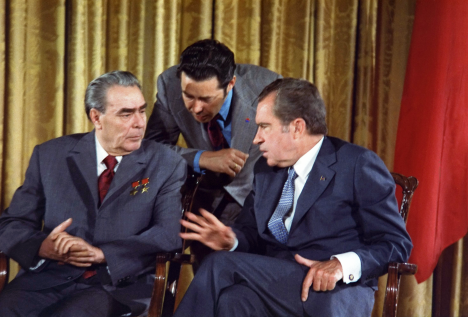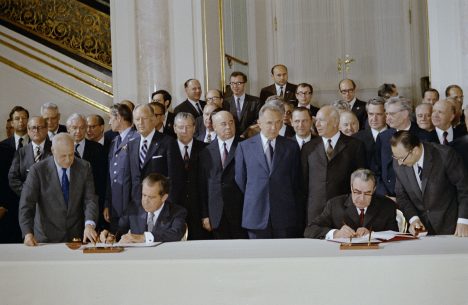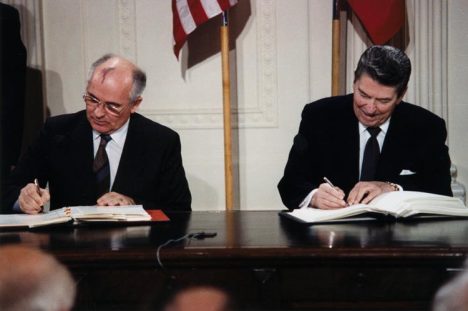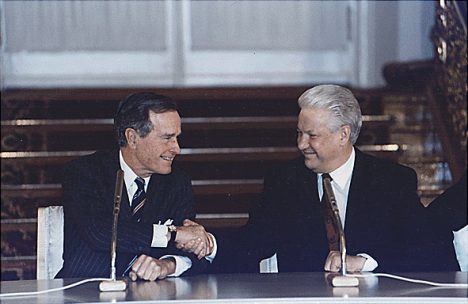Bilateral Disarmament Agreements
Bilateral disarmament agreements are agreements between two states. The largest nuclear powers are and have always been the United States and Russia (formerly the Soviet Union). Since the 1970s, these states have entered into several disarmament agreements to reduce their nuclear arsenals and the mutual threat.

SALT
At the same time as the arms race between the US and the Soviet Union during the Cold War took on increasingly absurd proportions, the situation began to be questioned more and more, both within the countries and internationally. Already in the 1970s, the first agreements were signed by the United States and the Soviet Union: SALT I and SALT II, Strategic Arms Limitation Talks, to limit the states’ strategic nuclear arsenals.

Anti-Ballistic Missile Treaty - ABM
In 1972, the ABM Agreement, the Anti-Ballistic Missile Treaty, was concluded between the United States and the Soviet Union to limit anti-ballistic missile systems used as counterattacks against missile-launched nuclear weapons. The US withdrew from the agreement in 2002 despite massive protests both domestically and internationally and immediately thereafter began development of an ABM system that would have been prohibited under the agreement.
During the second half of the 1980s, a time of disarmament began instead of rearmament. The United States and the Soviet Union (later replaced by Russia) began negotiating which nuclear weapons could be abolished.

Intermediate-Range Nuclear Forces - INF
In 1987, the Soviet Union and the United States concluded a new agreement, the Intermediate-Range Nuclear Forces, INF agreement, which stated that all intermediate-range missiles must be abolished. That is, the nuclear weapons that have a relatively short range. The US and the Soviet Union also talked about reducing their strategic nuclear weapons, i.e. those with a longer range.
In 2019, both the US and Russia terminated the INF Treaty. The reason, according to the US, was because Russia violated the agreement for a long time. Many have been critical of the decision and believe that the risk of nuclear war and the uncertainty for Europe increases. In the fall of 2019, the United States tested missiles that were previously prohibited under the agreement.

START and SORT
In 1991, the agreement START I, Treaty on the Reduction and Limitation of Strategic Offensive Arms, was concluded between the two countries. Negotiations on the reduction of the strategic weapons continued even after the dissolution of the Soviet Union.
In 1993, US President George Bush the Elder and Russian President Boris Yeltsin signed START II. According to START II, by 2003 the United States and Russia would have no more than 3,500 strategic nuclear weapons deployed each. START II never entered into force, but was instead replaced by the Strategic Offensive Reduction Treaty, SORT, in May 2002.
According to SORT, by 2012 both countries would have reduced their strategic nuclear arsenals to a level of between 1,700 and 2,200 nuclear weapons. The SORT agreement lacked control mechanisms and also did not require that the weapons that are disarmed be destroyed.

New START
New START entered into force in 2011 after being signed by US President Obama and then Russian President Medvedev in Prague on April 8, 2010. The agreement succeeded the SORT agreement, which expired in 2012. New START was a step forward from SORT as it now again got a control mechanism with inspections that disarmament is really being carried out.
Under New START, the countries have agreed to limit the number of deployed strategic nuclear warheads to 1,550 and reduce the number of missile carriers by half, it is about robot silos, submarines, bombers and more. However, there is still no limit on how many how many nuclear warheads countries can stockpile.
Russia and the US pledged to achieve the goals within 7 years and the agreement is valid for ten years, with the possibility of extending the agreement by 5 years. In February 2021, the agreement was extended by five years and expires in 2026.

Sources and more information
Strategic Arms Limitation Talks, SALT I, Arms Control Association
Strategic Arms Limitation Talks, SALT II, Arms Control Association
Anti-Ballistic Missile Treaty, Arms Control Association
Intermediate-Range Nuclear Forces, Arms Control Association
Treaty on the Reduction and Limitation of Strategic Offensive Arms, START I, Arms Control Association
Treaty on the Reduction and Limitation of Strategic Offensive Arms, START II, Arms Control Association
The Strategic Offensive Reductions Treaty (SORT) At a Glance, Arms Control Association
New START Treaty, U.S Department of State
New START at a glance, Arms Control Association




